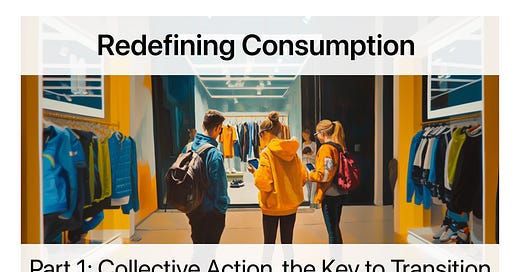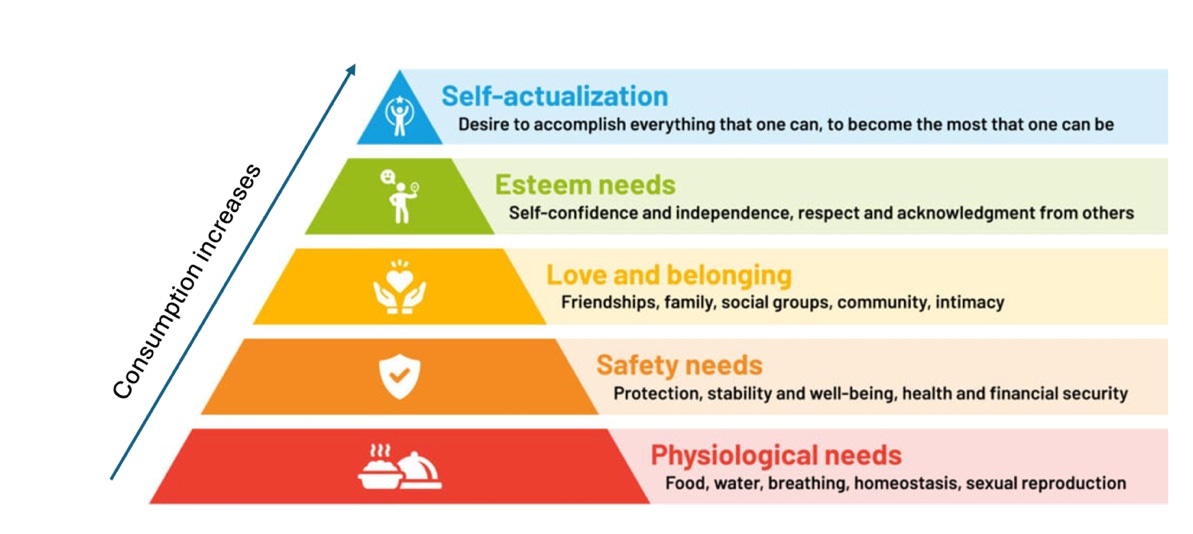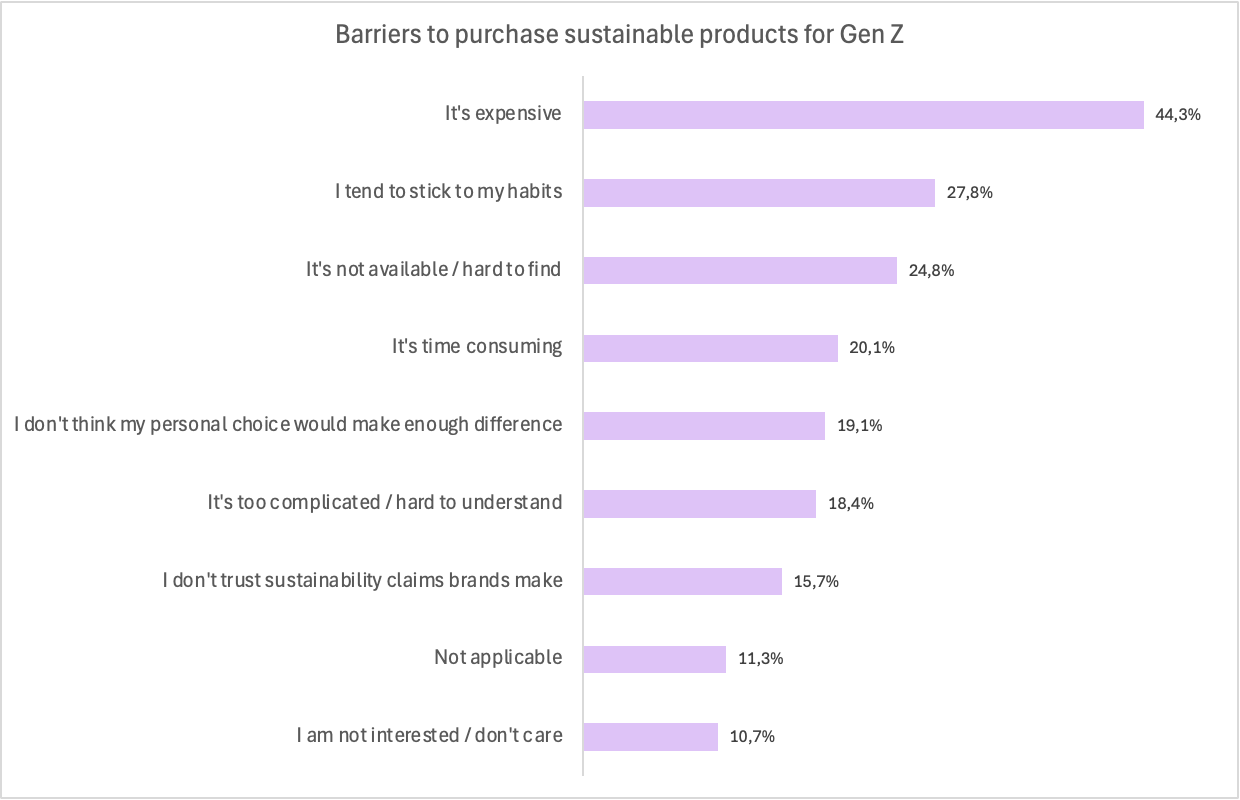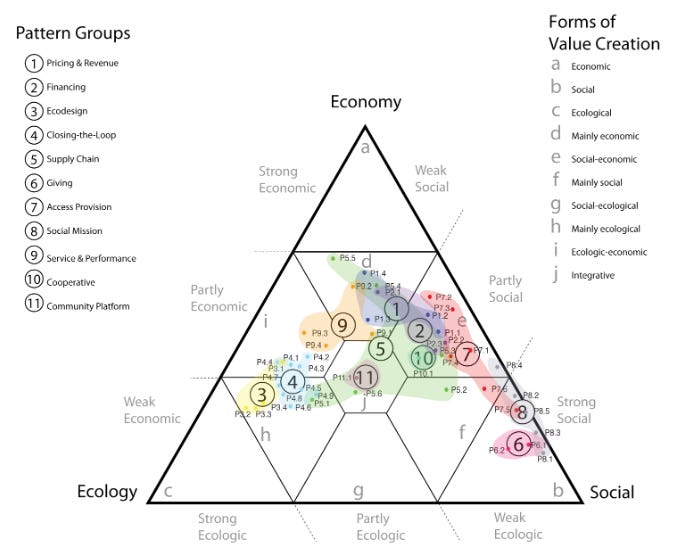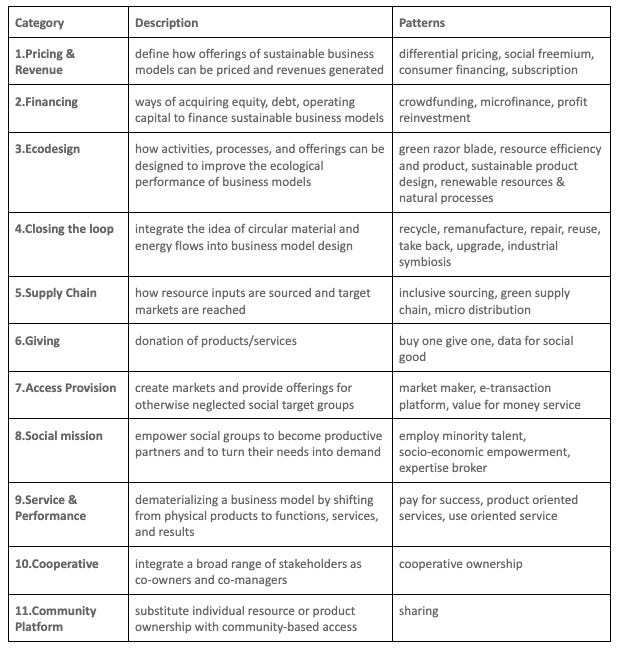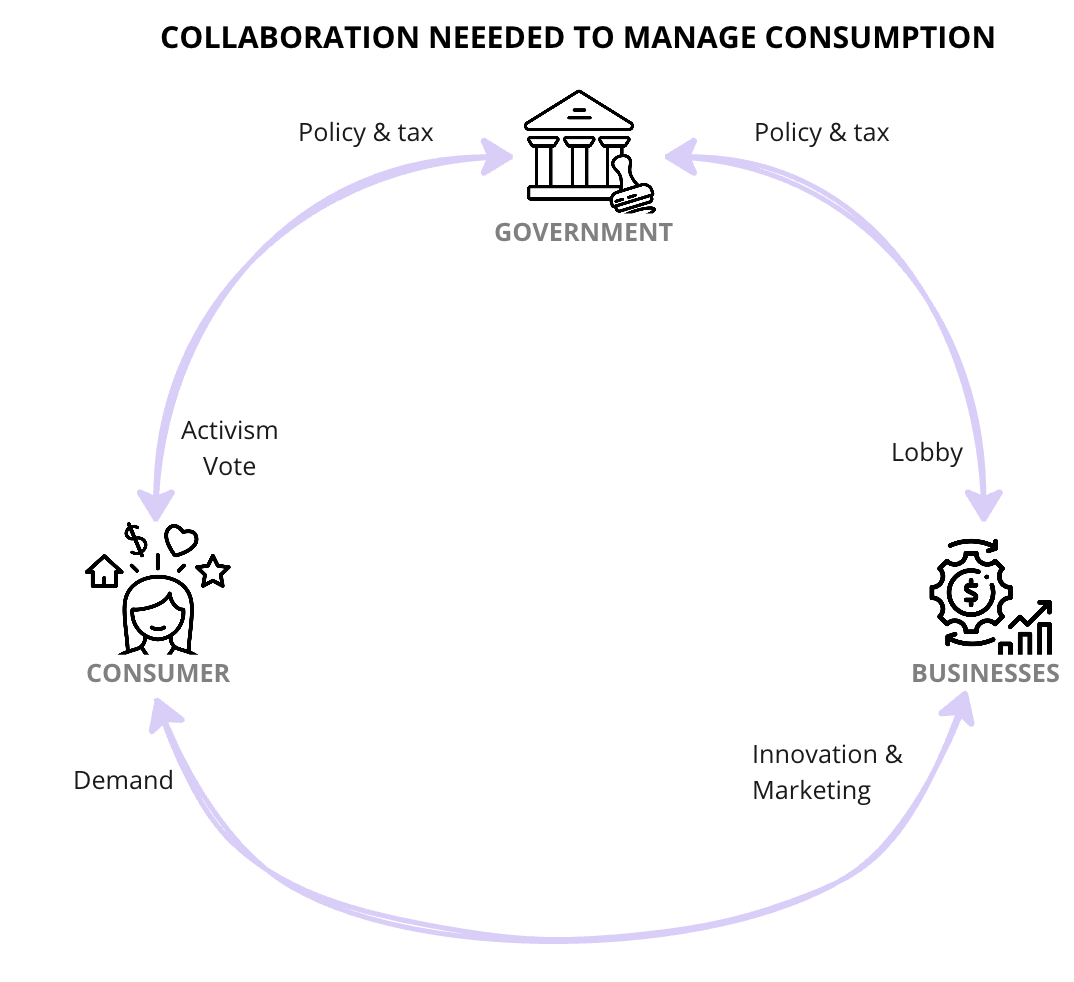Redefining Consumption - Part 1
Collective Action, the Key to Transition from Ownership to an Access Economy
Welcome to Climate Drift - the place where we dive into climate solutions and help you find your role in the race to net zero.
If you haven’t subscribed, join here:
Hey there! 👋
Skander here!
Transitioning from a linear to a circular economy is no small feat—it requires a fundamental shift in how we think about consumption and business.
Enter Nadia, a digital and e-commerce veteran with 15 years of experience working with giants like Nike, TOMS, and adidas.
In this first part of her three-part challenge, she maps out the landscape of consumption, from its psychological roots to the changing patterns of Gen Z, and explores how businesses and governments can drive sustainable change.
This is a roadmap for consumers, businesses, and policymakers to collaboratively reshape our economic model.
🌊 Let's dive in
Join the Climate Drift Accelerator and turn your passion into action. We are selecting people for our next cohort now, and we're looking for talented individuals like you to make a real difference.
🚀 Apply today: Be part of the solution
Hi I’m Nadia, a Digital and E-commerce leader with over 15 years of experience in sportswear and lifestyle industries, I bring a strategic mindset with a pragmatic approach to execution. My experience includes working with major brands such as Nike, TOMS, and adidas, among others. I have a deep yet comprehensive understanding of the dynamic and ever-evolving landscape of consumer behaviour, business, and technology. Driving 80% growth in corporate set up by delivering relevant consumer experience and fostering close collaboration with key stakeholders.
After developing circular services pilots, I’ve come to see the circular economy as a logical and exciting model for the future. It aligns profitability with sustainability, offering clear value to consumers—a business approach I strongly believe in. I specialise in identifying value exchanges between businesses and consumers, crafting innovative value propositions and business models that deliver creative and impactful solutions.
I’m thrilled to take you on a journey through my 3 parts Challenge that will embody this.
Part 1. Collective Action, the Key to Transition from Ownership to an Access Economy
This chapter talks about consumption as the root cause of our climate problem, and provides a framework for the next chapter. While consumption is an inevitable part of human life, we must ensure it stays within acceptable limits to protect our planet’s boundaries. Managing consumption requires a collective effort—discover your role in shaping this.
Part 2. State of the Industry through the Lens of Consumers, Business, and Government
Deep dive analysis of 5 industries current situation through the lens of consumers, business, and government using the framework outlined by the first chapter. Understanding the role they play, challenges, and best practices unique to the industry.
Part 3. Building a Circular Future: a Practical Guide to Starting a Circular Business model
A step-by-step guide on launching a profitable circular business with a clear value proposition for consumers, focusing on building a systemic approach to transform the business model.
INTRODUCTION
We consume a lot more per person and our population has grown exponentially over time, thanks to our intelligence and creativity in maximising resources. Our government’s overall success is measured by the monetary value of goods produced, encouraging people to buy more. This leads us to an ecological overshoot as we realised our resources are finite.
Human and consumptions are inseparable. Our behaviour for consumption is as old as humanity itself. To live is to consume.
Humans have succumbed to advertising ever since the snake whispered into Eve's ear in the Garden of Eden. Eve didn't need the forbidden fruit; there was plenty of other fruit around. But humans have a tendency to want more than what they need.
It’s a gradual and unintentional process. We started with Barter and Trade, followed by the Industrial Revolution, the Rise of Advertising, Post World War Boom, and the ongoing evolution of the Technological Revolution. Each phase accelerates our consumption, it also doesn’t help that we think we have an abundant amount of resources. Just like we thought the Earth was flat, we think our economy should be linear.
To slow down and manage consumption we need consumers, businesses, and the government to collectively take action and hold each other accountable. In this chapter I will deep dive into the source of our consumption, how it’s changing, and the role each one of us should play in managing consumption.
Table of Content:
The Psychology of Consumption
Hierarchy of Needs and Consumption
Inequality fuels Consumption as a consequence of Insecurities
The Dopamine Effect: Shopping and Pleasure
Gen Z and Changing Consumption Patterns: from Possession to Access
The Role of Business: from Triggering to Managing Consumption
Sustainable Business model Innovation
The Power of Marketing in Shaping Sustainable Consumption
The Role of Government in Managing Consumption
Policies to Enhance the Competitiveness of Sustainable Products
THE PSYCHOLOGY OF CONSUMPTION
Hierarchy of Needs and Consumption
To understand consumption we need to understand the core of human needs as explained by the Pyramid of Maslow.. Consumption increases as one’s need is fulfilled towards the top of the pyramid.
At the bottom of the pyramid are our basic needs, these are the needs which most of us find crucial and should be fulfilled before one can progress to pursue the rest of the pyramid. While the pyramid shows a clear hierarchy, I believe the rest of the needs could be in different order of priority depending on cultural background, personal situation, and desire.
The higher up the pyramid, the more needs are driven by psychological aspirations for personal growth, rather than by the absence of something.
The psychological aspects of our needs are influenced by our various aspects eg. culture, beliefs, and education therefore the driving factors will vary for most of us. However at the core of consumer culture is materialism, a set of values that centre around social status, possessions, and display of wealth. The gravity of a person’s materialism would predict how much a consumer they will be.
Materialism has been useful in the course of human evolution, it is the driving force to maintain our standing in the community, an essential part of being human. It's safe to say human consumerism is driven by materialism which is a natural behaviour of a social being who strives towards social acceptance and belonging in a community.
This explains the predicament we are in today. If consumption is an undeniable part of being human, and reproduction is part of our nature this means over time there are many more of us who consume much more.
This leaves us with two options: either we produce much more or we want less. So far, we have opted for the first option, which has led us to an ecological overshoot. Given that we live in a world with finite resources, perhaps it's time to try the second option....before it's too late.
Inequality fuels Consumption as a consequence of Insecurities
The world consumes unevenly due to disparities in purchasing power. Inequality drives consumerism in two ways: psychologically and economically.
Modern research confirms that inequality helps drive consumerism, mainly by intensifying status competition, so obvious markers of wealth and success become more important, which makes pursuit of money more important. Simply put, inequality pushes materialistic value - The Day The World Stop Shopping by J.B. Mackinnon
This status of competition makes people look at themselves in comparison to others materialistically, and feel what they have is not enough even though previously they were content with what they owned. Inequality triggers insecurity within individuals who measure success through material wealth. The Sustainable Fashion Forum has written that the more insecure you feel, the more likely you are to use shopping as a distraction. Individuals might buy clothing to compensate for perceived inadequacies
The Dopamine Effect: Shopping and Pleasure
Dave, who is a serious runner, heard from his running buddy how they love their sports watch. It's a Monday and Dave is not in the mood to start his working day. Therefore he thought he would just quickly browse through Google and check the possible options to kick off his week. Five minutes turned into an hour and he kept watching youtube videos of influencers explaining the different benefits, imagining what he could do with it and how it would help him train for the next ultra marathon. Finally, he found the best sports watch out there that matches exactly with his needs.
According to the Sustainable Fashion Forum there have been studies observing the brain activities through MRI when individuals conduct the act of shopping, and it shows a surge in dopamine level, a neurotransmitter associated with pleasure and reward. The journey starts with browsing through the possible options, finding something new as a temporary escape from routine. Followed by the potential of getting something new which possibly opens up new experiences.
Our excitement towards product/experience wears off, over time we get used to having certain things and take it for granted. As our reward system progresses our craving for novelty accelerates, and we want more. We don’t need new clothes every month, but as fast fashion brands accommodate our need for social acceptance and belonging, we buy more.
Gen Z and Changing Consumption Patterns: from Possession to Access
Gen Z is the first generation to grow up fully immersed in smartphones and social media, seamlessly integrating digital technology into nearly every aspect of their lives. This constant connectivity has impacted Gen Z both positively and negatively. However, they are the first generation to grow up with unprecedented access to information, shaping their worldview in ways no generation before them has experienced. This makes them extremely analytical and savvy in research, as a result they can have an informed purchase decision at their fingertips anywhere anytime. Gen Z demands brands to fulfil their sustainable promises not only through their marketing, but also throughout their end to end value stream. They have a good understanding of how businesses operate early enough in their life.
Unlike Millennials, this generation is growing up in economic and political instability, on top of that having experienced global pandemics at an early age. This has shaped the way Gen Zers view their consumption and relationship with brands. According to a 2022 research climate change remains the biggest concern among Gen Z for the next five years. When we look at their consideration phase, sustainability and ethics are at the top of their list, however this somehow doesn’t always translate into their purchasing behaviour. To better understand the challenges, here are the top barriers preventing Gen Z from purchasing sustainable options:
As this generation is maturing and more are entering the workforce, their purchasing power will increase and their price trade off slowly dissipates. Meanwhile there are opportunities to incentivize sustainable habits and facilitate Gen Z with access to sustainable options that fits their lifestyle.
Gen Zers analyse not only what they buy but also the very act of consuming. Consumption has also gained a new meaning. For Gen Z—and increasingly for older generations as well—consumption means having access to products or services, not necessarily owning them.
As access becomes the new form of consumption, unlimited access to goods and services (such as car-riding services, video streaming, and subscriptions) creates value. Products become services, and services connect consumers -
McKinsey and company | ‘True Gen’: Generation Z and its implications for companies
By redefining relationships with products and looking at it as access to services that connect consumers, there is hope in transforming our need for sense of belonging that has been driving our materialistic needs into something that would let us collaborate and bring us closer together in a more meaningful way.
We have seen an example of this happening in the transportation industry. BlaBlaCar is an online marketplace for carpooling. It connects drivers and passengers who are willing to travel together between cities and share the cost of the journey. This new business model brings convenience to consumers, reducing carbon footprints, and bringing together people who otherwise might never have interacted with each other.
REDEFINING THE ROLE OF BUSINESS: FROM TRIGGERING TO MANAGING CONSUMPTION
The next generation consumers expect brands and businesses to play a key role in the fight against climate change. The challenge for businesses lies in the need for a systemic transformation of their operations and business models. The larger the scale, the more difficult and complex this shift becomes.
Sustainable Business model Innovation
Often when we talk about innovation, typically product innovation comes to mind.
Business model innovation requires a more systemic approach to innovation. It changes how companies deliver, capture, and create value.
Sustainable business model innovation improves the company's ability to create, maintain or regenerate natural social economic capital beyond its organisational boundaries. By changing the value proposition for its customers and all other stakeholders and the way value is created, delivered, and captured -
Copenhagen Business School: Business Models for Sustainability
Arguably the biggest challenge for companies in implementing this shift is the need to collaborate and drive change beyond their organisational boundaries and immediate stakeholders, influencing broader ecosystems and supply chains. This sometimes requires partnership even with their direct competitors. Depending on the industry or sector, this transformation will present unique challenges. However, one crucial factor remains constant across all sectors: a company's ability to look beyond immediate business gains and short-term goals, focusing instead on long-term sustainability and future impact.
A framework created by Florian Lüduke-Freund helps us understand the different possibilities to create sustainable business models from the lens of 3 dimensions: Economic, Ecological and Social value creation. In total there are 45 patterns which are categorised in 11 groups.
This highlights the vast range of potential opportunities for businesses to begin exploring, opening new avenues for innovation and growth while aligning with sustainability goals. It can be used to start designing value creation of a new business as well as analysing existing companies in their sustainability impact depending on the model they have chosen. I will use this framework to analyse existing businesses in chapter 2.
The Power of Marketing in Shaping Sustainable Consumption
The success of marketing and advertisement in helping businesses sell products/services are driven by understanding the core of our needs as social beings and trigger us to consume more than we need. Digital ads accelerate this and make sure there is no escape for consumers. Marketers are naturally adept at analysing consumer behaviour, understanding where their audience spends the most time, and identifying the key influencers who shape their decisions.
Gen Z spends most of their time on social media, finding their inspiration by looking at influencers and funny videos. They don’t trust what big brands say and rather find comfort and advice from their peers or micro influencers. Digital marketers analyse these behaviours and collaborate with social media platforms to monetize this evolving landscape. We need marketers on our side, leveraging their expertise to drive positive change and use their "superpowers" for good.
According to research and experiments by HBR: The Elusive Green Consumer:
There are five actions that companies could consider in applying to encourage sustainable consumption: use social influence, shape good habits, leverage the domino effect, decide whether to talk to the heart or the brain, and favour experiences over ownership.
THE ROLE OF GOVERNMENT IN MANAGING CONSUMPTION
Government plays a big role in reinforcing and scaling sustainable development. Well thought policies give sustainable businesses a fair chance to compete in the market, whereas fines and penalties can push commercial brands to invest in sustainable products and business models. The EU has announced a circularity action plan in several sectors, followed up with a timeline when certain policies will be taken into action. This forces corporations to act and build their circularity model to comply with the regulation, and at the same time opens up opportunities for new ventures to help big brands achieve their goal.
Policies to Enhance the Competitiveness of Sustainable Products
We often assume that lower prices lead to increased purchases of certain products. However when it comes to repeat purchase and loyalty, consumers will likely buy from the same brand if they experience the full extent of a product. They tend to use the products more when they feel the cost, hence they are more inclined to make full use of it, build emotional relationships, and hold on to it longer. You can think of this as thoughtful purchasing, as opposed to impulse buying. During impulse buying you don’t take full consideration of cost vs. value a product will bring. It’s driven purely by the spur of the moment. Social media plays a big role in accelerating impulse buying, it has even become a trend with #tiktokmademebuyit or #instagrammademebuyit. This trend and hashtags somehow give social acceptance to impulse buying since people in the same social group are doing the same thing.
Considering inequality in buying power and different types of products/services needed, dynamic pricing schemes should be applied. The key question is how do we ensure sustainable products are affordable and competitive with non sustainable ones, without increasing consumption?
There are a couple of possible scenarios where government policy and support could make a big difference:
Encourage innovation on technology that decreases the cost to produce green products/services to be affordable by lower income group
Tax non green products based on the carbon footprint it produces
Subsidise pricing for essential products/services which fulfil the requirements of sustainable practices
Place a higher tax on non essential products/services
Besides reinforcing policy, the government can also provide space and the right environment to test/pilot innovative and sustainable business models. Creating community and for start-ups to thrive and subsidise certain sectors where there is a gap.
CONCLUSION
To slow down and manage consumption we need consumers, businesses, and government to collectively take action and hold each other accountable: [This is illustrated by the above visual]
Consumers → Business: demand for green products/services, circular business model
Consumers → Government: vote for government that has clear agenda for climate solutions
Government → Business: put policy in place to force corporation to take actions and change the way they do business, tax non green products, and subsidise sustainable business models
Government → Consumers: support lower income consumers through subsidy, influence pricing through tax
Business → Government: give input to future policy to help government to make the right decisions
Business → Consumers: transform traditional business based on economic gains only to sustainable business model, use marketing to encourage consumers to build new habits
Thank you so much for reading the first chapter of my article, if you find it insightful please share it as wide as possible. Together, we have the power to shape a brighter, more circular future.
If you're a new business exploring circular models or a corporation building a team to pilot circular models, let's connect—I'd love to help you get started.
WHAT’S NEXT?
In the next chapter I will deep dive into 5 sectors to understand where we are in managing consumption through the lens of consumers, business, and government. This chapter is enriched with real-world use cases of circular models piloted by various brands. Stay tuned!


